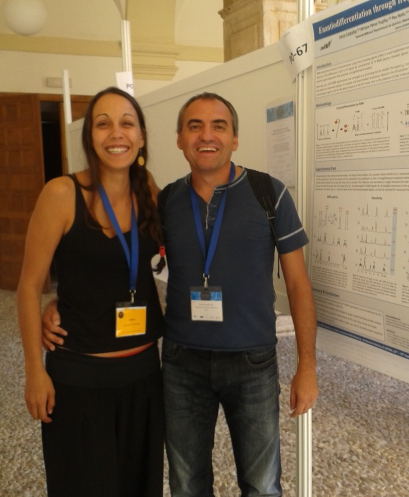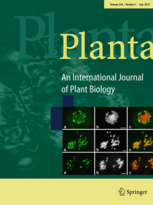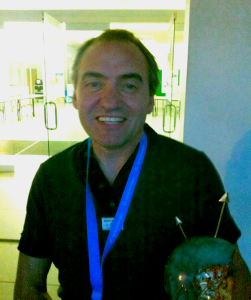Laura Castañar is top finalist to the Lilly XII Research Awards for Graduate Students. The prize is awarded to ten Spanish young scientists, three awardees and seven finalists, for their research contributions in the field of chemistry. The awards ceremony took place at Lilly Research & Development Centre in Alcobendas, Madrid, Spain, the 26th September, 2014. Continue reading Lilly Research Award to Laura Castañar
All posts by Miquel
Laura Castañar’s oral communication gets accessit award at GERMN 2014

Laura Castañar is honoured by JANSSEN with the accessit prize for her oral communication Enantiodifferentiation through Frequency-Selective Pure-Shift 1H NMR at the VII Biennial Meeting of the Nuclear Magnetic Resonance Group of the Spanish Royal Society of Chemistry / IV Iberian NMR Meeting / VI Ibero-American NMR Meeting (GERMN 2014) held in Alcalá de Henares, Spain, from 22nd to 24th September, 2014.
Continue reading Laura Castañar’s oral communication gets accessit award at GERMN 2014
CcpNmr Analysis – A useful tool for organic chemistry nmr?
SeRMN seminar
- Date: Thursday 13th February, 2014
- Hour: 10 am
- Location: SeRMN, Facultats de Ciències i Biociències, C2/-135
- Speaker: Miquel Cabañas, SeRMN
CcpNmr Analysis is a graphics-based interactive NMR spectrum visualisation, resonance assignment and data analysis program developed by The Collaborative Computing Project for NMR. as part of the CcpNmr suite of programs. Continue reading CcpNmr Analysis – A useful tool for organic chemistry nmr?
Josep Saurí wins Best Poster Award at SMASH 2013
Josep Saurí wins the Best Poster Award at the Small Molecule NMR Conference (SMASH) held in Santiago de Compostela, Spain, on 22nd – 25th September, 2013. Continue reading Josep Saurí wins Best Poster Award at SMASH 2013
Free sugars quantification in intact plant tissue by HR-MAS NMR.
 “Assessment of a 1H high-resolution magic angle spinning NMR spectroscopy procedure for free sugars quantification in intact plant tissue” Teresa Delgado-Goñi, Sonia Campo, Juana Martín-Sitjar, Miquel E. Cabañas, Blanca San Segundo, Carles Arús; Planta, 238:397-413, 2013 (PDF file). DOI: 10.1007/s00425-013-1924-y
“Assessment of a 1H high-resolution magic angle spinning NMR spectroscopy procedure for free sugars quantification in intact plant tissue” Teresa Delgado-Goñi, Sonia Campo, Juana Martín-Sitjar, Miquel E. Cabañas, Blanca San Segundo, Carles Arús; Planta, 238:397-413, 2013 (PDF file). DOI: 10.1007/s00425-013-1924-y
In most plants, sucrose is the primary product of photosynthesis, the transport form of assimilated carbon, and also one of the main factors determining sweetness in fresh fruits. Traditional methods for sugar quantification (mainly sucrose, glucose and fructose) require obtaining crude plant extracts, which sometimes involve substantial sample manipulation, making the process time-consuming and increasing the risk of sample degradation. Here, we describe and validate a fast method to determine sugar content in intact plant tissue by using high-resolution magic angle spinning nuclear magnetic resonance spectroscopy (HR-MAS NMR). Continue reading Free sugars quantification in intact plant tissue by HR-MAS NMR.
Job offer for the TRANSACT-ITN project
We are recruiting an Early Stage Researcher to work on the Development of Decision Support System & Spectral Classification tool meta-plug-ins for the jMRUI platform as part of the TRANSACT-ITN European project.

We seek a highly motivated and qualified individual as Early Stage Researcher for a three-year applied research project. The successful candidate will contribute to the development of advanced biomedical research tools in the field of Magnetic Resonance Spectroscopy and Imaging, and its application to the clinical day-to-day practice.
The position is intended for a young post-graduate student/researcher, with a Master degree or equivalent on Engineering or Computer Science, and with a proficient knowledge of the Java programming language. Prior experience on signal and/or image processing, segmentation and pattern recognition applications in the field of biomedical research is an asset, particularly in the field of Magnetic Resonance Spectroscopy and/or Imaging.
Continue reading Job offer for the TRANSACT-ITN project
TRANSACT-ITN project awarded to GABRMN, SeRMN & CIBER-BBN
 Transforming Magnetic Resonance Spectroscopy into a Clinical Tool (TRANSACT) is an European research project awarded in the call FP7-PEOPLE-2011-ITN, of the 7th Framework Programme Marie-Curie Actions, to a network of partners including the GABRMN and SeRMN at UAB, and the associated partner CIBER-BBN. The project is coordinated by Prof. Sabine Van Huffel, Prof. Uwe Himmelreich, and Dr. Diana Sima, of the Department of Electrical Engineering ESAT-SCD, and Department of Imaging & Pathology, Biomedical MRI Unit, Katholieke Universiteit Leuven, Leuven, Belgium. Scientist-in-charge at UAB will be Prof. Carles Arús (GABRMN) and Miquel Cabañas (SeRMN), and Dr. Margarida Julià-Sapé will be scientist-in-charge at CIBER-BBN. Dr. Silvia Lope-Piedrafita (SeRMN) will take part in the project as senior scientist.
Transforming Magnetic Resonance Spectroscopy into a Clinical Tool (TRANSACT) is an European research project awarded in the call FP7-PEOPLE-2011-ITN, of the 7th Framework Programme Marie-Curie Actions, to a network of partners including the GABRMN and SeRMN at UAB, and the associated partner CIBER-BBN. The project is coordinated by Prof. Sabine Van Huffel, Prof. Uwe Himmelreich, and Dr. Diana Sima, of the Department of Electrical Engineering ESAT-SCD, and Department of Imaging & Pathology, Biomedical MRI Unit, Katholieke Universiteit Leuven, Leuven, Belgium. Scientist-in-charge at UAB will be Prof. Carles Arús (GABRMN) and Miquel Cabañas (SeRMN), and Dr. Margarida Julià-Sapé will be scientist-in-charge at CIBER-BBN. Dr. Silvia Lope-Piedrafita (SeRMN) will take part in the project as senior scientist.
Continue reading TRANSACT-ITN project awarded to GABRMN, SeRMN & CIBER-BBN
Teodor Parella, SeRMN Director, receives GERMN-Bruker NMR Award
 Dr. Teodor Parella, Director of the NMR Service and Associate Professor in the Chemistry Department at Universitat Autònoma de Barcelona, received last September the GERMN-Bruker Award at the VI GERMN Bienal Meeting held in Aveiro, Portugal, for his contributions to the development and application of the NMR spectroscopy technique. Continue reading Teodor Parella, SeRMN Director, receives GERMN-Bruker NMR Award
Dr. Teodor Parella, Director of the NMR Service and Associate Professor in the Chemistry Department at Universitat Autònoma de Barcelona, received last September the GERMN-Bruker Award at the VI GERMN Bienal Meeting held in Aveiro, Portugal, for his contributions to the development and application of the NMR spectroscopy technique. Continue reading Teodor Parella, SeRMN Director, receives GERMN-Bruker NMR Award
How does HR-MAS spin rate affect the spectral pattern of mobile lipids?
 “Influence of the spinning rate in the HR-MAS pattern of mobile lipids in C6 glioma cells and in artificial oil bodies” Juana Martín-Sitjar, Teresa Delgado-Goñi, Miquel E. Cabañas, Jason Tzen, Carles Arús; Magnetic Resonance Materials in Physics, Biology and Medicine, 2012, 25(6):487-496. DOI: 10.1007/s10334-012-0327-6
“Influence of the spinning rate in the HR-MAS pattern of mobile lipids in C6 glioma cells and in artificial oil bodies” Juana Martín-Sitjar, Teresa Delgado-Goñi, Miquel E. Cabañas, Jason Tzen, Carles Arús; Magnetic Resonance Materials in Physics, Biology and Medicine, 2012, 25(6):487-496. DOI: 10.1007/s10334-012-0327-6
Object: To evaluate how spinning rate affects mobile lipid (ML) resonances visibility in HR-MAS spectra of C6 glioma cells and artificial oil bodies (AOB), as models of cytosolic lipid droplets. Materials and methods: Using C6 cells and AOB of two different sizes, 780 ± 580 and 240 ± 293 nm, as models, we acquired HR-MAS pulse and acquire spectra at different spinning rates between 500 and 15,000 Hz, all at 37 °C. Continue reading How does HR-MAS spin rate affect the spectral pattern of mobile lipids?
New data server
During the course 2008-2009 we started to plan the replacement of the computer acting as firewall and data server. Our main goal was to improve privacy by replacing the internal users shared account with separate account to each research group, through which they would have access exclusively to their data folder on each spectrometer. Continue reading New data server